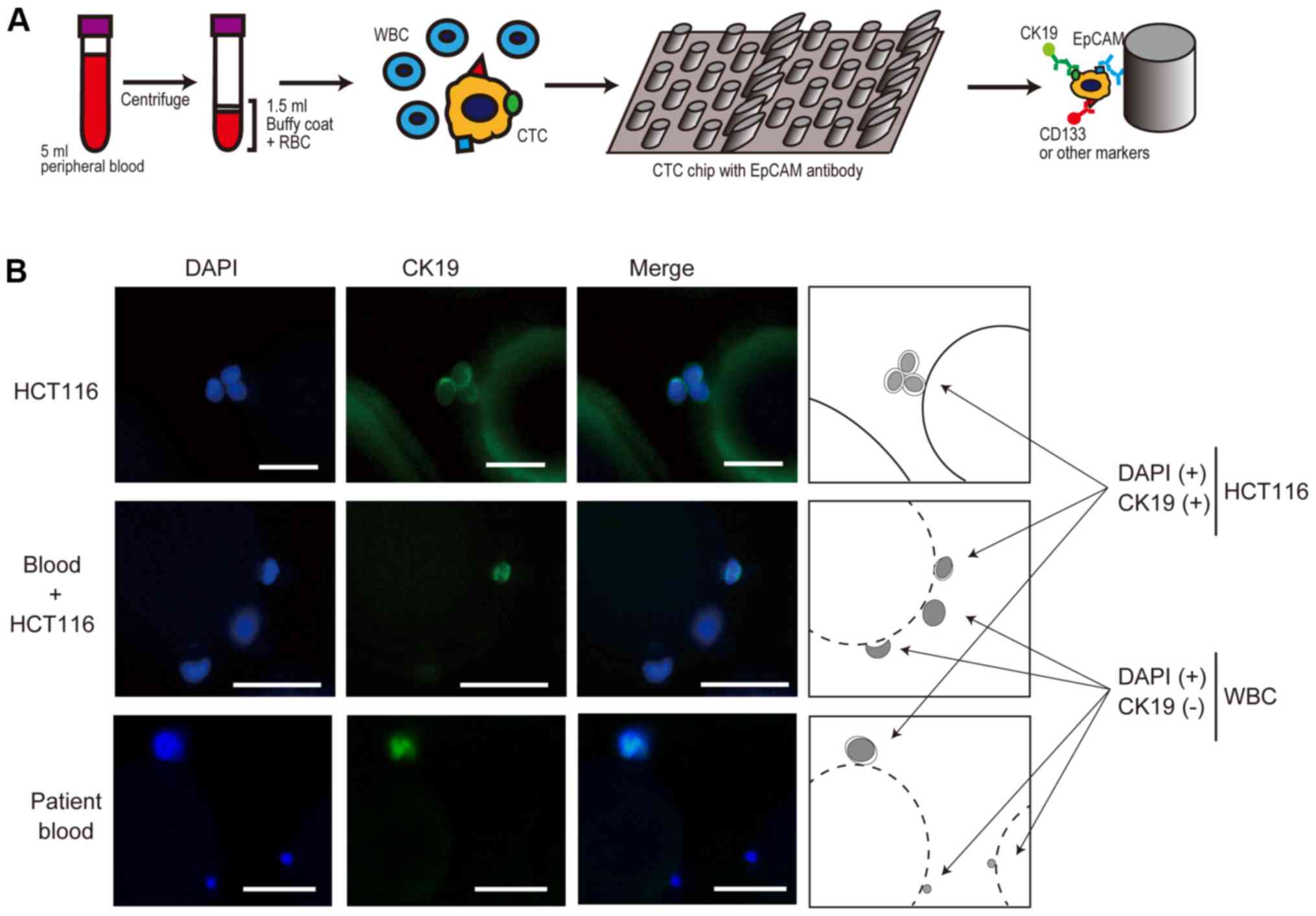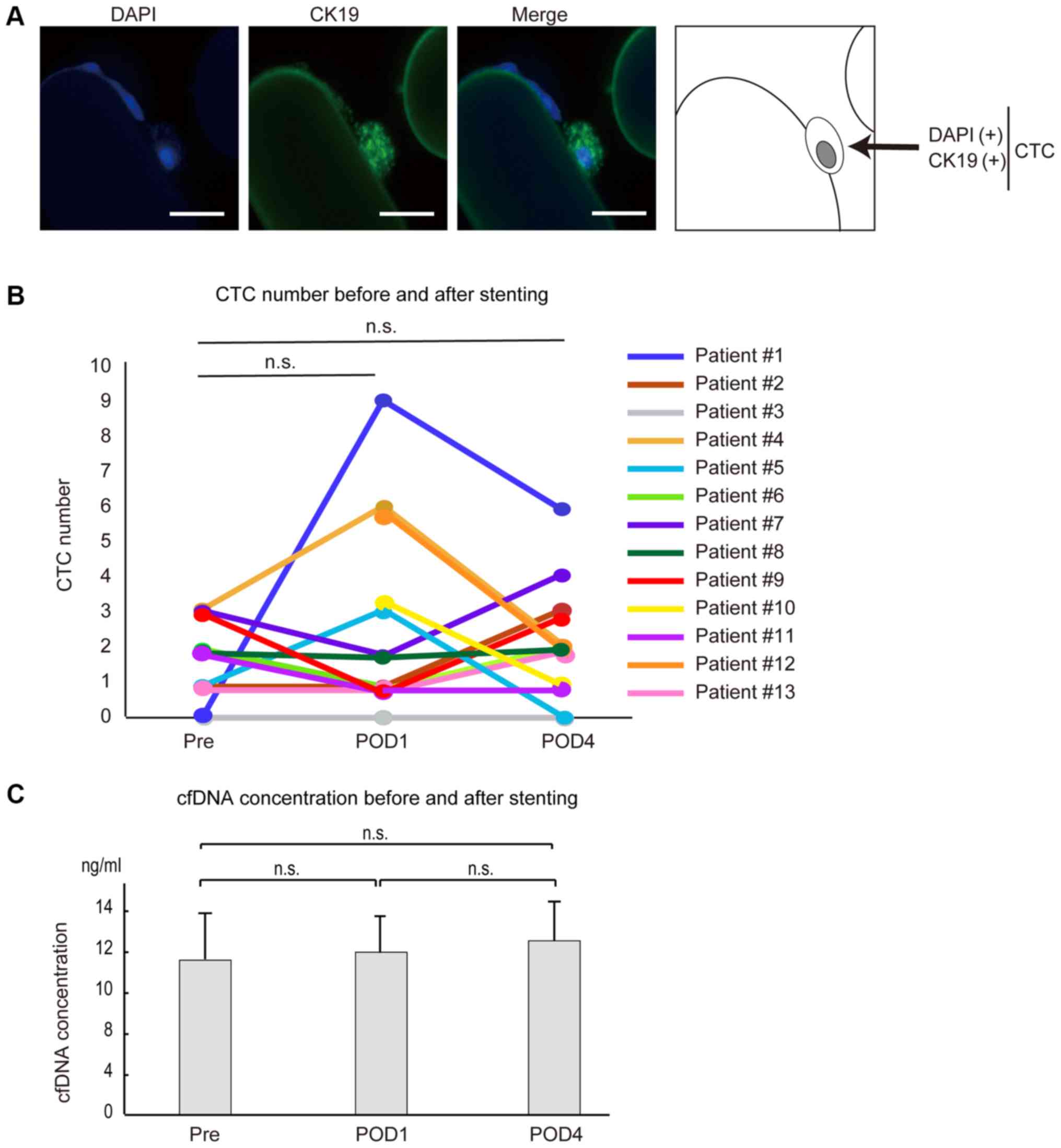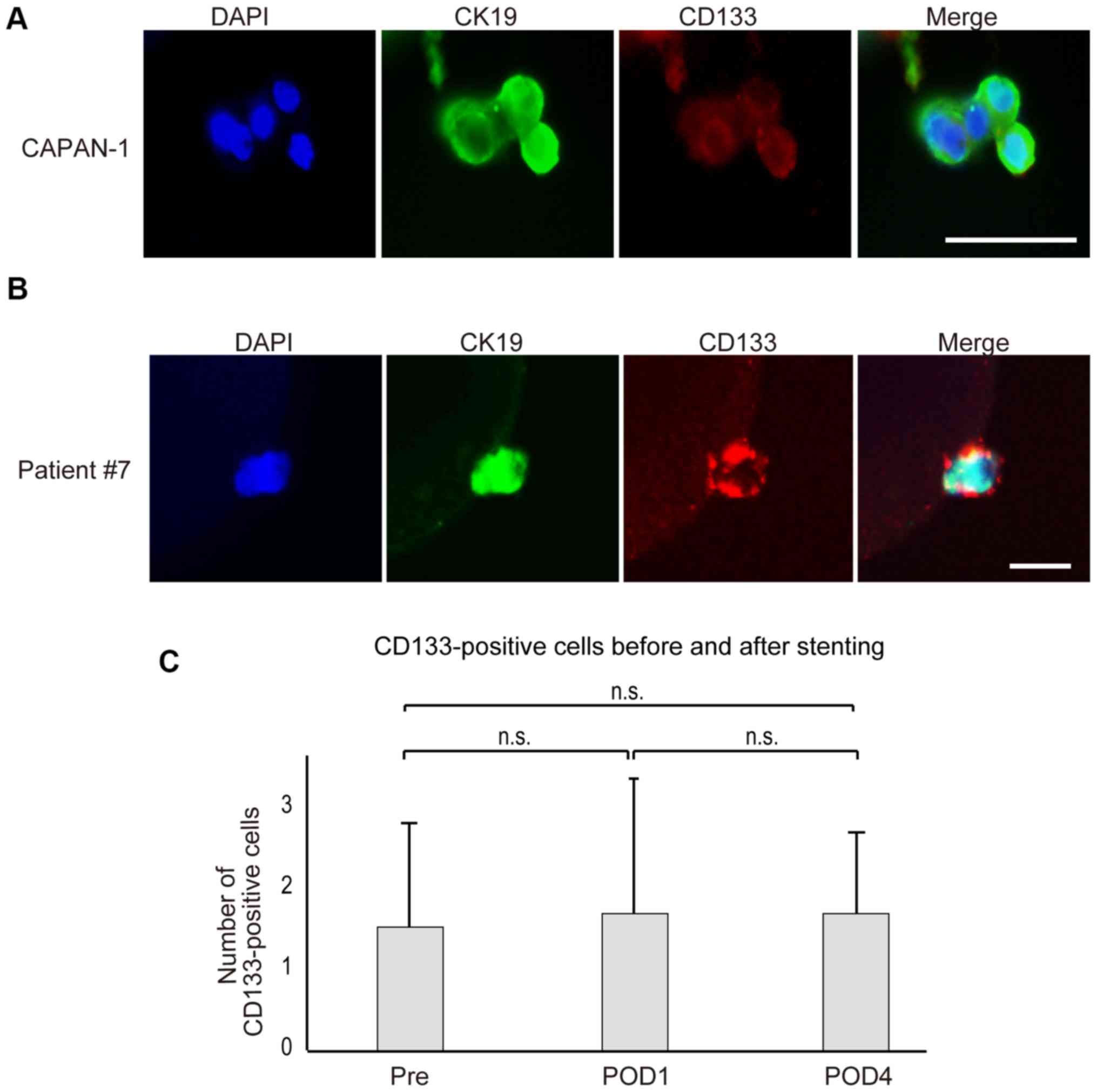|
1
|
de Albuquerque A, Kubisch I, Stölzel U,
Ernst D, Boese-Landgraf J, Breier G, Stamminger G, Fersis N and
Kaul S: Prognostic and predictive value of circulating tumor cell
analysis in colorectal cancer patients. J Transl Med. 10:2222012.
View Article : Google Scholar : PubMed/NCBI
|
|
2
|
Ohnaga T, Shimada Y, Takata K, Obata T,
Okumura T, Nagata T, Kishi H, Muraguchi A and Tsukada K: Capture of
esophageal and breast cancer cells with polymeric microfluidic
devices for CTC isolation. Mol Clin Oncol. 4:599–602. 2016.
View Article : Google Scholar : PubMed/NCBI
|
|
3
|
Su DW and Nieva J: Biophysical
technologies for understanding circulating tumor cell biology and
metastasis. Transl Lung Cancer Res. 6:473–485. 2017. View Article : Google Scholar : PubMed/NCBI
|
|
4
|
Gabriel MT, Calleja LR, Chalopin A, Ory B
and Heymann D: Circulating tumor cells: A review of non-EpCAM-based
approaches for cell enrichment and isolation. Clin Chem.
62:571–581. 2016. View Article : Google Scholar : PubMed/NCBI
|
|
5
|
Chikaishi Y, Yoneda K, Ohnaga T and Tanaka
F: EpCAM-independent capture of circulating tumor cells with a
‘universal CTC-chip’. Oncol Rep. 37:77–82. 2017. View Article : Google Scholar : PubMed/NCBI
|
|
6
|
Global Burden of Disease Cancer
Collaboration, ; Fitzmaurice C, Akinyemiju TF, Al Lami FH, Alam T,
Alizadeh-Navaei R, Allen C, Alsharif U, Alvis-Guzman N, Amini E, et
al: Global, regional, and national cancer incidence, mortality,
years of life lost, years lived with disability, and
disability-adjusted life-years for 29 cancer groups, 1990 to 2016:
A systematic analysis for the global burden of disease study. JAMA
Oncol. 4:1553–1568. 2018. View Article : Google Scholar : PubMed/NCBI
|
|
7
|
Little MW, Oakley T, Briggs JH, Sutcliffe
JA, Allouni AK, Makris G, Bratby MJ, Tapping CR, Patel R, Wigham A,
et al: Technical and clinical outcomes following colonic stenting:
A seven-year analysis of 268 procedures. Cardiovasc Intervent
Radiol. 39:1471–1478. 2016. View Article : Google Scholar : PubMed/NCBI
|
|
8
|
Saito S, Yoshida S, Isayama H, Matsuzawa
T, Kuwai T, Maetani I, Shimada M, Yamada T, Tomita M, Koizumi K, et
al: A prospective multicenter study on self-expandable metallic
stents as a bridge to surgery for malignant colorectal obstruction
in Japan: Efficacy and safety in 312 patients. Surg Endosc.
30:3976–3986. 2016. View Article : Google Scholar : PubMed/NCBI
|
|
9
|
Saida Y, Enomoto T, Takabayashi K, Otsuji
A, Nakamura Y, Nagao J and Kusachi S: Outcome of 141 cases of
self-expandable metallic stent placements for malignant and benign
colorectal strictures in a single center. Surg Endosc.
25:1748–1752. 2011. View Article : Google Scholar : PubMed/NCBI
|
|
10
|
Maruthachalam K, Lash GE, Shenton BK and
Horgan AF: Tumour cell dissemination following endoscopic stent
insertion. Br J Surg. 94:1151–1154. 2007. View Article : Google Scholar : PubMed/NCBI
|
|
11
|
Sabbagh C, Browet F, Diouf M, Cosse C,
Brehant O, Bartoli E, Mauvais F, Chauffert B, Dupas JL, Nguyen-Khac
E and Regimbeau JM: Is stenting as ‘a bridge to surgery’ an
oncologically safe strategy for the management of acute,
left-sided, malignant, colonic obstruction? A comparative study
with a propensity score analysis. Ann Surg. 258:107–115. 2013.
View Article : Google Scholar : PubMed/NCBI
|
|
12
|
van den Berg MW, Sloothaak DA, Dijkgraaf
MG, van der Zaag ES, Bemelman WA, Tanis PJ, Bosker RJ, Fockens P,
ter Borg F and van Hooft JE: Bridge-to-surgery stent placement
versus emergency surgery for acute malignant colonic obstruction.
Br J Surg. 101:867–873. 2014. View
Article : Google Scholar : PubMed/NCBI
|
|
13
|
Yamashita S, Tanemura M, Sawada G, Moon J,
Shimizu Y, Yamaguchi T, Kuwai T, Urata Y, Kuraoka K, Hatanaka N, et
al: Impact of endoscopic stent insertion on detection of viable
circulating tumor cells from obstructive colorectal cancer. Oncol
Lett. 15:400–406. 2018.PubMed/NCBI
|
|
14
|
Takahashi G, Yamada T, Iwai T, Takeda K,
Koizumi M, Shinji S and Uchida E: Oncological assessment of stent
placement for obstructive colorectal cancer from circulating
cell-free DNA and circulating tumor DNA dynamics. Ann Surg Oncol.
25:737–744. 2018. View Article : Google Scholar : PubMed/NCBI
|
|
15
|
de Sousa e Melo F, Kurtova AV, Harnoss JM,
Kljavin N, Hoeck JD, Hung J, Anderson JE, Storm EE, Modrusan Z,
Koeppen H, et al: A distinct role for Lgr5+ stem cells in primary
and metastatic colon cancer. Nature. 543:676–680. 2017. View Article : Google Scholar : PubMed/NCBI
|
|
16
|
Chen S, Song X, Chen Z, Li X, Li M, Liu H
and Li J: CD133 expression and the prognosis of colorectal cancer:
A systematic review and meta-analysis. PLoS One. 8:e563802013.
View Article : Google Scholar : PubMed/NCBI
|
|
17
|
Nagata H, Ishihara S, Kishikawa J, Sonoda
H, Murono K, Emoto S, Kaneko M, Sasaki K, Otani K, Nishikawa T, et
al: CD133 expression predicts post-operative recurrence in patients
with colon cancer with peritoneal metastasis. Int J Oncol.
52:721–732. 2018.PubMed/NCBI
|
|
18
|
Ohnaga T, Shimada Y, Moriyama M, Kishi H,
Obata T, Takata K, Okumura T, Nagata T, Muraguchi A and Tsukada K:
Polymeric microfluidic devices exhibiting sufficient capture of
cancer cell line for isolation of circulating tumor cells. Biomed
Microdevices. 15:611–616. 2013. View Article : Google Scholar : PubMed/NCBI
|
|
19
|
Cima I, Kong SL, Sengupta D, Tan IB, Phyo
WM, Lee D, Hu M, Iliescu C, Alexander I, Goh WL, et al:
Tumor-derived circulating endothelial cell clusters in colorectal
cancer. Sci Transl Med. 8:345ra892016. View Article : Google Scholar : PubMed/NCBI
|
|
20
|
Tilney HS, Lovegrove RE, Purkayastha S,
Sains PS, Weston-Petrides GK, Darzi AW, Tekkis PP and Heriot AG:
Comparison of colonic stenting and open surgery for malignant large
bowel obstruction. Surg Endosc. 21:225–233. 2007. View Article : Google Scholar : PubMed/NCBI
|
|
21
|
Arezzo A, Balague C, Targarona E, Borghi
F, Giraudo G, Ghezzo L, Arroyo A, Sola-Vera J, De Paolis P,
Bossotti M, et al: Colonic stenting as a bridge to surgery versus
emergency surgery for malignant colonic obstruction: Results of a
multicentre randomised controlled trial (ESCO trial). Surg Endosc.
31:3297–3305. 2017. View Article : Google Scholar : PubMed/NCBI
|
|
22
|
Schild T, Low V, Blenis J and Gomes AP:
Unique metabolic adaptations dictate distal organ-specific
metastatic colonization. Cancer Cell. 33:347–354. 2018. View Article : Google Scholar : PubMed/NCBI
|
|
23
|
Zeki SS, Graham TA and Wright NA: Stem
cells and their implications for colorectal cancer. Nat Rev
Gastroenterol Hepatol. 8:90–100. 2011. View Article : Google Scholar : PubMed/NCBI
|
|
24
|
Riethdorf S, Fritsche H, Müller V, Rau T,
Schindlbeck C, Rack B, Janni W, Coith C, Beck K, Jänicke F, et al:
Detection of circulating tumor cells in peripheral blood of
patients with metastatic breast cancer: A validation study of the
CellSearch system. Clin Cancer Res. 13:920–928. 2007. View Article : Google Scholar : PubMed/NCBI
|

















